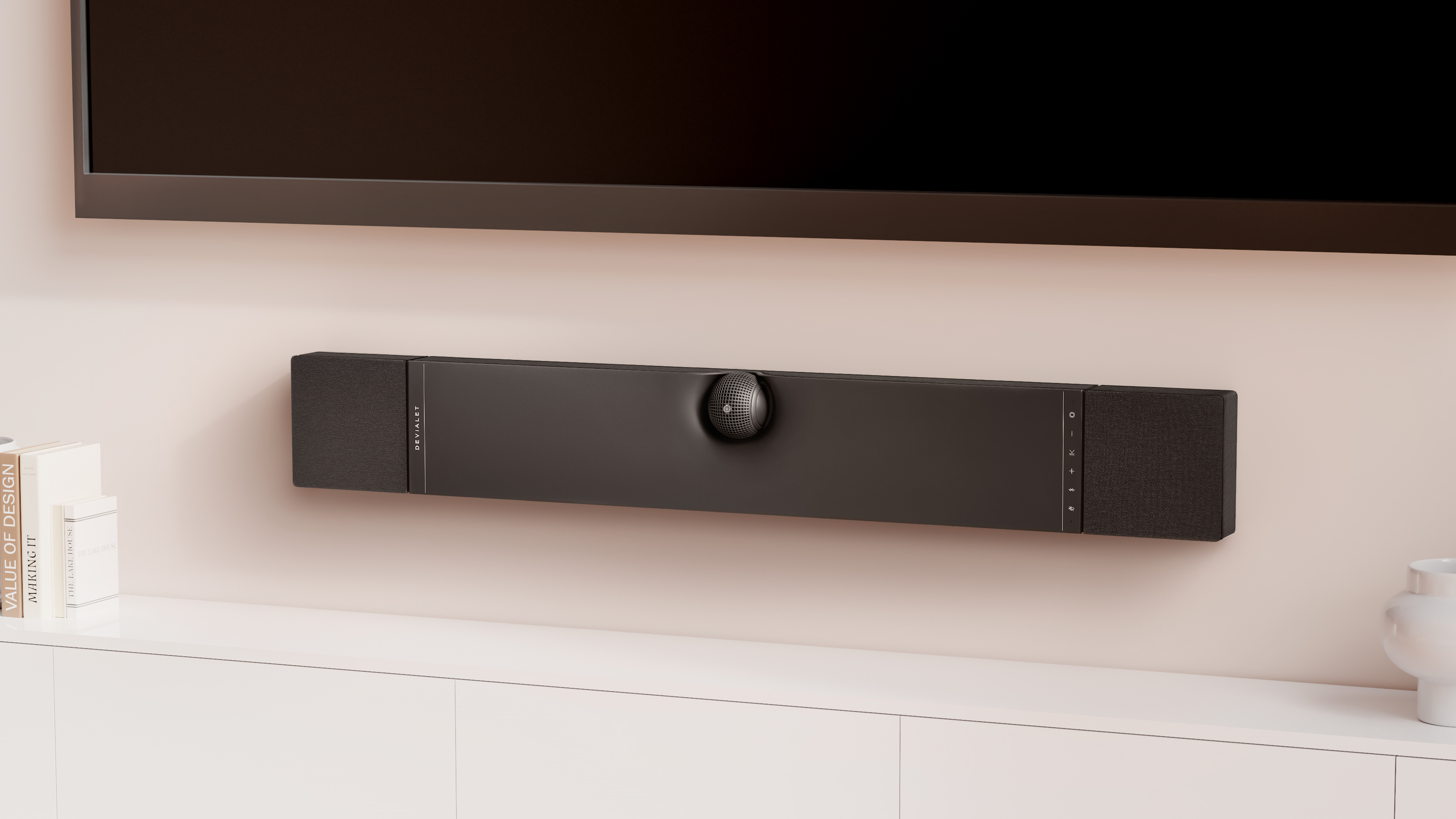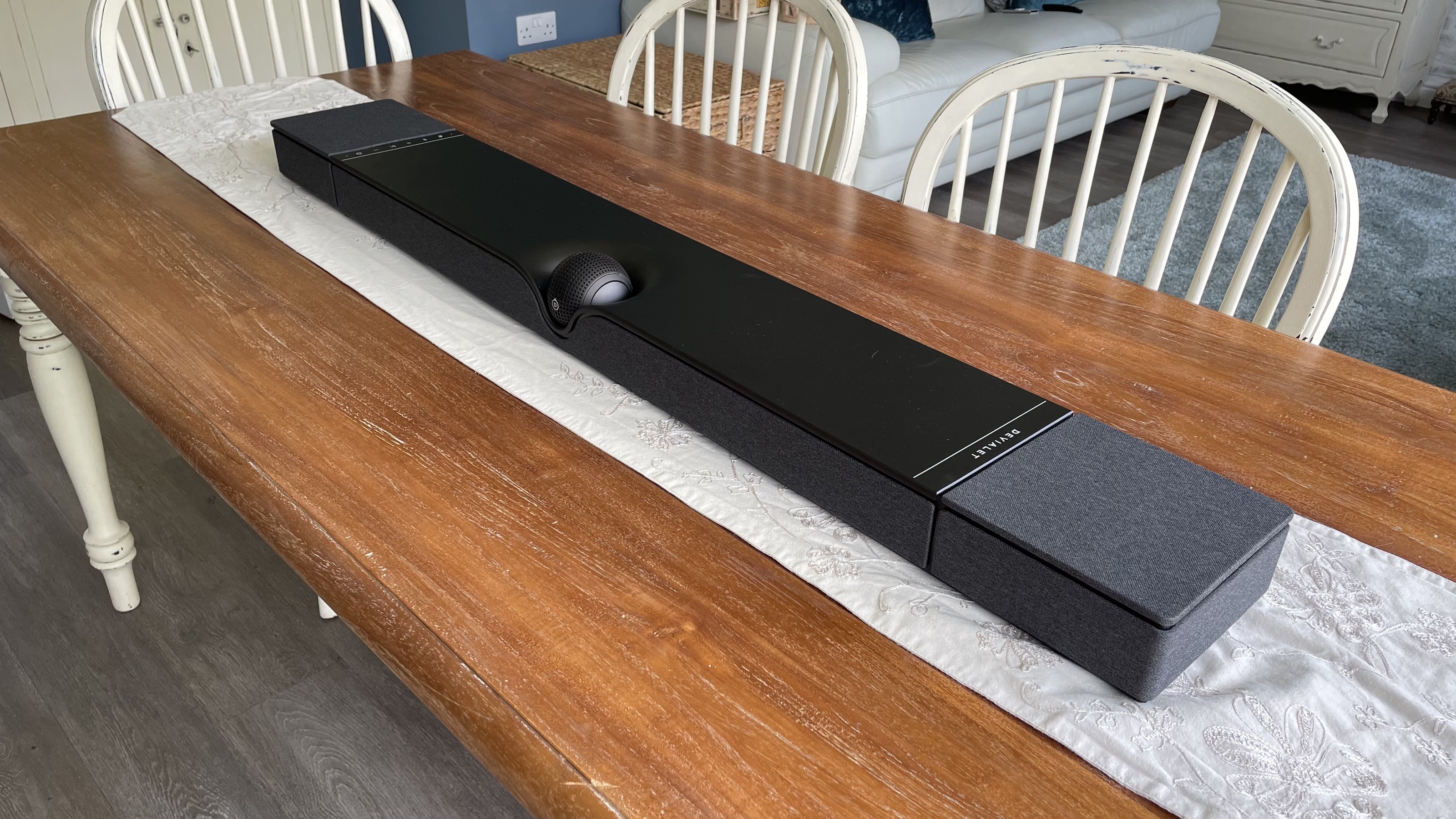I was blown away by the subwoofer-less bass of this Dolby Atmos soundbar
The Devialet Dione proves you can get full sound from a single box

The reason that the best soundbars are so popular right now is that they can give you the feeling of a big, impactful theater system, but without the hassle of trying to fit in multiple speakers and wiring them all up. They're so much smaller and easier to accommodate.
But if you want your soundbar to be as low-footprint as possible, you have a difficult choice: do you get a soundbar with a separate subwoofer, so that you get the full range of sound down to deep bass, but with more space taken up in your room; or do you get a single-unit soundbar with no subwoofer, but less impactful bass.
Lots of people are choosing the latter, partly for convenience (just two cables to set up a system and you're away), and partly because a lot of people still think of a subwoofer as something that unnecessarily shakes the walls.
That's a shame – because a good sub doesn't rattle the shelves, but does add an underlying foundation of bass to soundtracks that makes a huge difference to the realism of some scenes. The example I like to give isn't in action soundtracks or sci-fi effects, but when I watched a movie set by the sea, with huge crashing waves that should be moody and threatening. Without a subwoofer, they splash; with a sub, they thunder into the ocean with realistic power and menace. It's more true to life, and reflects how the movie was meant to be heard.
Now finally, there's a single-unit soundbar that delivers genuinely deep bass: the Devialet Dione. It features eight speaker drivers just focusing on landing great low-end performance, all the way down to 24Hz (20Hz is generally considered the lowest for human hearing to discern, so this soundbar basically reaches a low as it's worth going).
You can read our full (gushing) Devialet Dione review for what we thought about everything from its Dolby Atmos positioning skills to how its ingenious design that includes a rotating sphere… but I want to focus on the bass, because that's really its magic trick.
Both big and clever
When I tested the Dione, the impact of the bass compared to other single-unit soundbars is clear from the second you fire up anything with even an ounce of thump.
A muscle car's acceleration starts from your diaphragm, a door slam echoes through the floor, ominous soundtracks coat the room like treacle.
The Sony HT-A7000 soundbar is the big-name option that's come closest to achieving this from a single unit, but it's still a long way away. And the Dione is in a totally new league for bass compared to the Sonos Arc, which is the most popular big Atmos soundbar that doesn't come with a sub.
Every time I listen to the Sonos Arc without a subwoofer, I'm reminded of just how much it misses out compared to much cheaper soundbars that do come with one.
So the Dione really blew me away – it felt like a full-on home theater experience (albeit without real surround sound).

The brilliance of Dione's design is in how it arranges its woofer drivers. They're grouped in pairs, with one facing forward and one facing to the rear, exactly behind it. You've got two pairs on the left, and two on the right.
The reason for this is two-fold: it creates a more even, direction-less bass sound (which is what you want); and it reduces external vibrations from the big bass drivers to almost nothing, so that it doesn't cause your TV stand to vibrate.
This is called a force-cancelling driver system, or sometimes a push-push system. A problem speakers have is Newton's Third Law: every action has an equal and opposite reaction. When you push sound vibrations out the front of a speaker, that causes reactionary vibrations to go backwards into the unit. High-end speakers are made from very heavy, absorbent material to soak this up. But smaller units can end up rattling from these vibrations, interfering with the sound.
But if you put in an identical speaker facing the opposite direction, firing the exact same sound, then the two sets of unwanted reactionary vibrations meet in the middle, and cancel each other out. A stoppable force meets an equally stoppable force, and they… stop.
That's a simplified explanation, but it's the basic principle, and it works incredibly well here, enabling the Dione to push rich sound in a single box.
To make it happen, Devialet has had to devote a huge portion of the (quite large) soundbar's volume to these speakers, and it's also an extremely expensive soundbar at $2,400 / £1,990. Both of these could easily rule it out for people… but make no mistake, there's nothing else quite like it. Even the almighty Sennheiser Ambeo 3D soundbar.
Get daily insight, inspiration and deals in your inbox
Sign up for breaking news, reviews, opinion, top tech deals, and more.

Matt is TechRadar's Managing Editor for Entertainment, meaning he's in charge of persuading our team of writers and reviewers to watch the latest TV shows and movies on gorgeous TVs and listen to fantastic speakers and headphones. It's a tough task, as you can imagine. Matt has over a decade of experience in tech publishing, and previously ran the TV & audio coverage for our colleagues at T3.com, and before that he edited T3 magazine. During his career, he's also contributed to places as varied as Creative Bloq, PC Gamer, PetsRadar, MacLife, and Edge. TV and movie nerdism is his speciality, and he goes to the cinema three times a week. He's always happy to explain the virtues of Dolby Vision over a drink, but he might need to use props, like he's explaining the offside rule.